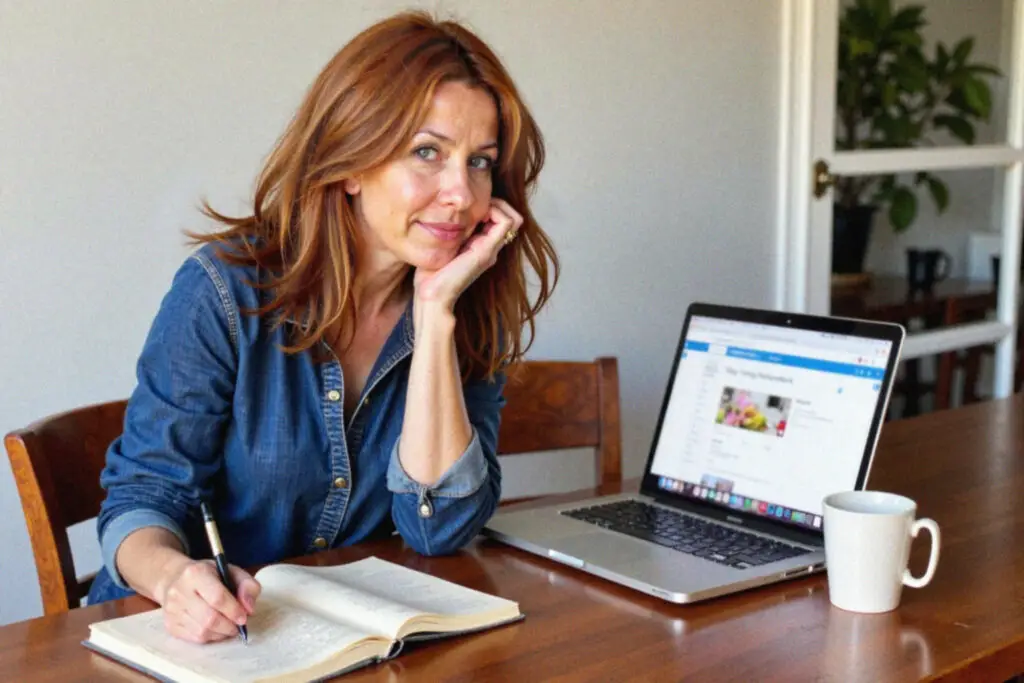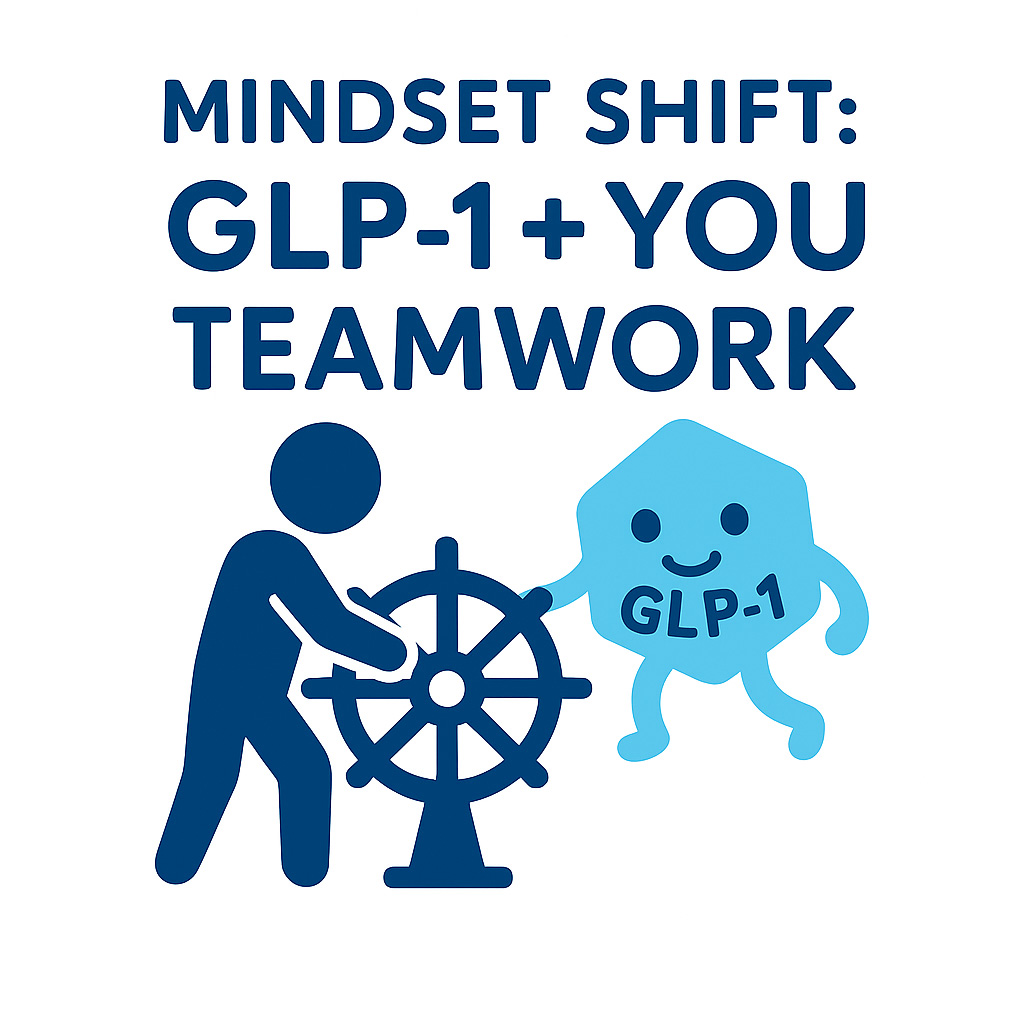Author’s Note: Claire Aldington is a fictional character used to share patient insights. “5 Things I wish I knew Before Starting GLP-1 Treatment” is based on personal perspective and research and should not be taken as medical instruction. Always consult a professional for personal health decisions.
5 Things I Wish I Knew...
In need of some GLP-1 treatment tips? I got you. Simply starting the process can feel like stepping into the unknown. When I began my journey, I scoured the internet for any help to prepare me for what was ahead.
Now, after months on GLP-1 medication, I’ve distilled the five most important things I wish I had known.

An AI-generated image of Claire. Before sharing her five must‑know lessons, Claire dives deep into online research to prepare for her GLP‑1 journey.
TIP 1: Expect Side Effects
🔥Hot Tip🔥
Don’t panic if you feel off in the first few weeks of GLP-1 treatment. I had waves of nausea and even some fatigue that made me second-guess the whole process. Later I learned these symptoms are very common…and tend to subside as the body adjusts. (I even wrote an honest account of the side effects I faced and the tricks that helped me through them.)
In fact, gastrointestinal symptoms like nausea, vomiting, and diarrhea (and yes, even constipation) are by far the most common side effects of GLP-1 medicationsHarvard.

These symptoms usually peak in the first few weeks, then fade as your body adjusts.
Loss of appetite is also expected – Cleveland Clinic notes the most common side effects include loss of appetite along with nausea, vomiting, and diarrheaCleveland Clinic. It’s just your body adjusting to new signals around hunger and digestion.
In my case, nausea peaked during weeks 2 and 3 and faded by week 5. If I had known the discomfort would likely resolve, I would’ve worried a lot less. Clinical studies show GI side effects tend to occur early and then subside as the body adjustsNIH.
TIP 2: Weight Loss Timing Varies
I expected to drop 10 pounds in a month. Instead? Nothing for the first two weeks. But then, seemingly overnight in week 3, the weight started coming off. It felt unreal. What I learned is that every body responds differently to GLP-1s. Some people see quick changes; others take longer to notice results.
In one large semaglutide trial, participants lost only about 10.6% of their starting weight by 20 weeks (roughly 5 months), with weight loss continuing gradually after thatNIH. The same study showed weight plateauing around 60–68 weeks, reaching about 17.4% total lossNIH.
Plateaus are totally normal, too. I hit one around three months but eventually broke through it by staying consistent.
💡 Fun Fact 💡
TIP 3: You Still Have to Do the Work
🔥Hot Tip🔥
I’ll admit, I hoped GLP-1 would be a magic fix. But I still had to make choices: healthy meals, smaller portions, and regular movement. What changed was the struggle got easier. The medication helped me feel satisfied faster and reduced my cravings.

You steer the habits; GLP‑1 just supplies the push.
In fact, GLP-1 drugs slow gastric emptying and increase satiety (helping you feel full sooner)NIH. That meant prioritizing protein and veggies became more doable, and an afternoon walk felt like a treat instead of a chore.
Mindset Shift: Think of GLP-1 as a teammate. It gives you momentum, but you’re still steering the ship. Once I accepted that partnership, choosing healthy habits felt empowering — not passive. I was doing the work, but with some friendly assistance.
TIP 4: Watch for Emotional Eating
Even if your physical hunger quiets, emotional hunger may not. With my stomach quiet, I still found myself reaching for snacks out of habit or stress. Even if your physical hunger quiets, emotional hunger may not. GLP-1 can quiet the physical food noise, but you’ll still need to address the feelings that drive eating.
Replacing old patterns with new rituals, a cup of tea, journaling, or a short walk, helped me a lot. That said, emotional eating can seriously challenge GLP-1 weight loss. One study found people with higher emotional eating scores had smaller brain responses to food cues on GLP-1 therapyNIH.
In other words, emotional eating can blunt the impact of these medications. If I had known this, I would’ve sought support sooner.
🔥Hot Tip🔥
TIP 5: Slow Is Sustainable

Starting low and going slow leads to steady, sustainable results — the data proves it.
I wanted fast results; bigger doses, faster weight loss. My provider insisted on gradual titration (upping my dose slowly) and I’m so glad I listened. Starting low and going slow gave my body time to adjust with fewer side effectsNIH.
It also gave me time to build routines that stuck. In the STEP trials of semaglutide, patients took about 16 weeks to reach the full 2.4 mg dose, and they lost roughly 10.6% of their starting weight by thenNIH. Imagine what would have happened if they tried to start at the highest dose!
Remember, even a small weekly loss adds up: losing 1–2 pounds a week is considered a healthy, sustainable pace by health expertsCDC. It may not sound like much day-to-day, but over time it’s a huge win, and it feels far better than a crash diet.
Final Thoughts: A Quieter Mind, a Fuller Life
Starting GLP-1 treatment was one of the best things I’ve done for my health, but I wish I’d begun with more realistic expectations. Here’s what I’d tell “earlier me”:
Expect temporary side effects, and prepare for them.
Don’t let the scale dictate success; look for other wins.
You’ll still have to make healthy choices, but they’ll feel more doable.
Emotional eating won’t vanish, but you’ll finally have space to work on it.
Go slow. That’s where the long-term wins live.
Give yourself grace… this journey is yours, and no one else’s timeline matters. (I learned that in my GLP-1 weight loss journey, and I promise it’s true.)
This journey is yours, and no one else’s timeline matters.
Disclaimer: This article is a personal narrative intended for informational purposes. It is not medical advice. Consult a healthcare professional for guidance on weight loss or any medical treatment. Also, note that Claire Aldington is a fictional character created to illustrate real experiences.
CITATIONS
health.harvard.edu. GLP-1 diabetes and weight-loss drug side effects: “Ozempic face” and more – Harvard Health. Gastrointestinal symptoms — nausea, vomiting, diarrhea, and constipation — are by far the most common side effects of GLP-1 drugs.
my.clevelandclinic.org. GLP-1 Agonists: What They Are, How They Work & Side Effects. * Loss of appetite . * Nausea. * 56. * Diarrhea.
pmc.ncbi.nlm.nih.gov. Switching Between Glucagon-Like Peptide-1 Receptor Agonists: Rationale and Practical Guidance – PMC. primarily nausea, vomiting, and diarrhea (Table 2). GI side effects usually occur early in the course of treatment. In the clinical experience of the authors, such effects tend to be variable in terms of severity and usually resolve with continuous use. These observations are supported by trial data. Lowering the dose of GLP-1 receptor agonist or using a slower titration regimen may help to mitigate these effects.
pmc.ncbi.nlm.nih.gov. Once-weekly 2.4 mg Semaglutide for Weight Management in Obesity: A Game Changer? – PMC. By the end of the run-in phase (16 weeks of dose escalation and 4 weeks of maintenance dose), 803 participants – who already had a mean loss of 10.6% of their baseline weight – were randomized in a 2:1 manner to either continue 2.4 mg semaglutide or receive placebo (plus lifestyle intervention in both groups) for an additional 48 weeks. The primary endpoint was percentage change in body weight from week 20 to week 68. By the end of the randomized period (week 68), participants on semaglutide had lost an additional 7.9% of their weight from the week 20 timepoint (with a plateau reached at week 60–68), while those switched to placebo had gained 6.9% (difference 14.8%, 95% CI -16.0 to -13.5; p<0.001). Participants in the semaglutide group also had significant improvements in waist
pmc.ncbi.nlm.nih.gov. Once-weekly 2.4 mg Semaglutide for Weight Management in Obesity: A Game Changer? – PMC. for an additional 48 weeks. The primary endpoint was percentage change in body weight from week 20 to week 68. By the end of the randomized period (week 68), participants on semaglutide had lost an additional 7.9% of their weight from the week 20 timepoint (with a plateau reached at week 60–68), while those switched to placebo had gained 6.9% (difference 14.8%, 95% CI -16.0 to -13.5; p<0.001). Participants in the semaglutide group also had significant improvements in waist circumference, blood glucose, systolic blood pressure and Short-Form 36 physical functioning score. By the end of the 68-week period, participants kept on semaglutide had lost 17.4% of their initial baseline weight – with ≥15%
pmc.ncbi.nlm.nih.gov. A clinical review of GLP-1 receptor agonists: efficacy and safety in diabetes and beyond – PMC. food intake. Their effects include increasing insulin secretion, decreasing glucagon release, increasing satiety, and slowing gastric emptying. There are currently four approved GLP-1 receptor agonists in the United States: exenatide, liraglutide, albiglutide, and dulaglutide. A fifth agent, lixisenatide, is available in Europe. There are important pharmacodynamic, pharmacokinetic, and clinical differences of each agent. The most common adverse effects seen with GLP-1 therapy include nausea, vomiting, and injection-site reactions. Other warnings and precautions include pancreatitis and thyroid cell carcinomas. GLP-1 receptor agonists are an innovative and effective option to improve blood
pubmed.ncbi.nlm.nih.gov. Eating behavior modulates the sensitivity to the central effects of GLP-1 receptor agonist treatment: a secondary analysis of a randomized trial – PubMed. Results: After 10 days, higher emotional eating scores were associated with less pronounced GLP-1RA induced reductions in brain responses to food pictures in the amygdala, insula and caudate nucleus. In addition, higher emotional eating scores tended to be associated with less pronounced GLP-1RA increases in brain responses to chocolate milk receipt in the caudate nucleus and insula. After 12 weeks, there were no significant associations between emotional eating scores and liraglutide-induced changes in brain responses to food cues. After 10
pmc.ncbi.nlm.nih.gov. Switching Between Glucagon-Like Peptide-1 Receptor Agonists: Rationale and Practical Guidance – PMC. authors, such effects tend to be variable in terms of severity and usually resolve with continuous use. These observations are supported by trial data. Lowering the dose of GLP-1 receptor agonist or using a slower titration regimen may help to mitigate these effects.
cdc.gov. Steps for Losing Weight | Healthy Weight and Growth | CDC. A lifestyle with good nutrition, regular physical activity, stress management, and enough sleep








